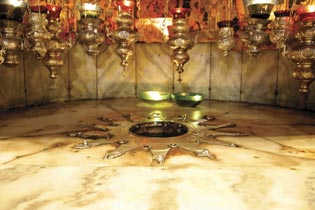 How the “House of Bread†became the birthplace of the “Bread of Lifeâ€
How the “House of Bread†became the birthplace of the “Bread of Lifeâ€
Bethlehem. The very name floods the imagination and stirs the emotions. God chose this tiny village, annually revered in churches and homes around the world, as the cradle of celestial joy, hope and peace. Each Christmas, young and old contemplate the reality and significance of the manger, the shepherds, the Magi and the Holy Family under the star of Bethlehem. In this hamlet one quiet, mysterious night 2,000 years ago, an event took place that forever changed the course of history.
Modern Bethlehem, a modest village of 30,000 inhabitants, is remarkably unchanged since the time of Jesus’ birth. Perched on the rugged slopes of the Judean desert about eight kilometres south of Jerusalem, Bethlehem sits along the main highway to Hebron and Egypt, known as The Way of the Patriarchs. Its Hebrew name, Beth-Lehem (“House of Breadâ€), well defines this fertile parcel of land. As they have through the ages, Bethlehem’s fields still supply nourishing grain, the olive grove’s distinctive oil and the vineyard’s succulent grapes.
Archaeologists are just beginning to excavate the site of ancient Bethlehem, located near the Church of the Nativity. Modern buildings make the task difficult. No one knows when the village was first occupied. Called Ephrath (“fruitfulâ€) in Jacob’s time, it became the burial place for his beloved wife, Rachel. Following their conquest of Canaan, the Israelites called the village Bethlehem. According to 1 Chronicles 2:51, Salma, one of Caleb’s sons, was the “Father of Bethlehem.†It was also the home of Ibzan, the 10th judge (see Judges 12:8), Elimelech, the father-in-law of Ruth (see Ruth 1:1-2), as well as the home of Ruth’s husband, Boaz.
The prophet Samuel established the town’s religious significance. He came to Bethlehem declaring, “I have come to sacrifice to the Lord. Consecrate yourselves and come to the sacrifice with me†(1 Samuel 16:5). Participants in that sacrifice-Jesse and his sons, along with their descendants-have immortalized Bethlehem. A thousand years after King David was born, his teenage progeny, Mary, gave birth to the King of kings in their ancestral home, “the city of David, which is called Bethlehem†(Luke 2:4 KJV).
In the second century, Justin Martyr recorded that Jesus’ birth took place “in a cave close to the village.†The probability that this cave is identical to the grotto of the Church of the Nativity is supported by one of history’s ironies. The Emperor Hadrian desecrated the Cave of the Nativity following the bloody repression of the Bar Kokhba revolt in AD 135. He encompassed the cave with a temple dedicated to the Roman god Adonis. Ironically, this desecration served to pinpoint the site forever.
Today, modern pilgrims follow well-worn steps that descend into the grotto directly under the altar of the Church of the Nativity. Bending down or kneeling in front of a 14-point silver star on a white marble floor, each worshipper reads the star’s Latin inscription: “Hic de Virgine Maria Jesus Christus natus est†(Here Jesus Christ was born to the Virgin Mary).
Here, in a hostel’s basement cave in the village known as “The House of Bread,†was born the Baby who would one day declare, “I am the bread of life… the living bread that came down from Heaven. Whoever eats of this bread will live forever. This bread is my flesh, which I will give for the life of the world†(John 6:48, 51). May the Babe of Bethlehem’s 21st-century followers respond as did his first century disciples-“Lord, evermore give us this bread†(John 6:34 KJV).
Let us celebrate Christmas 2007 with the resounding affirmation for the entire world to hear yet again: “Christ the Saviour is born!â€
Commissioner William W. Francis, Territorial Commander
Reprinted from Salvationist, December 2007
Photo: Church of the Nativity, Bethlehem